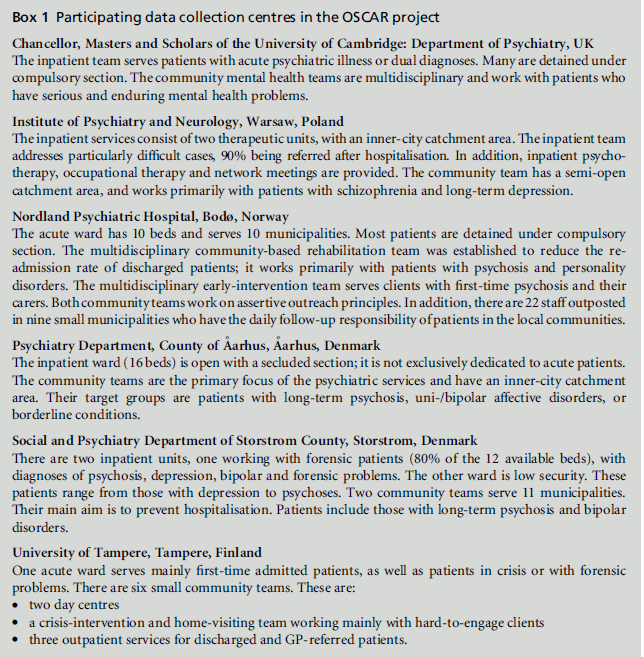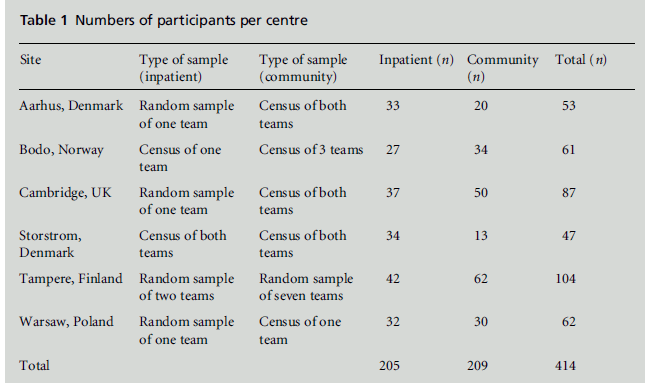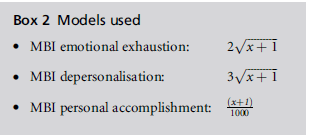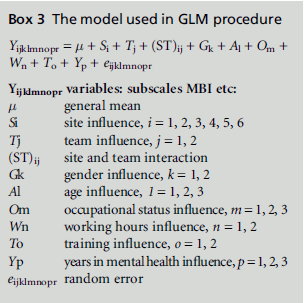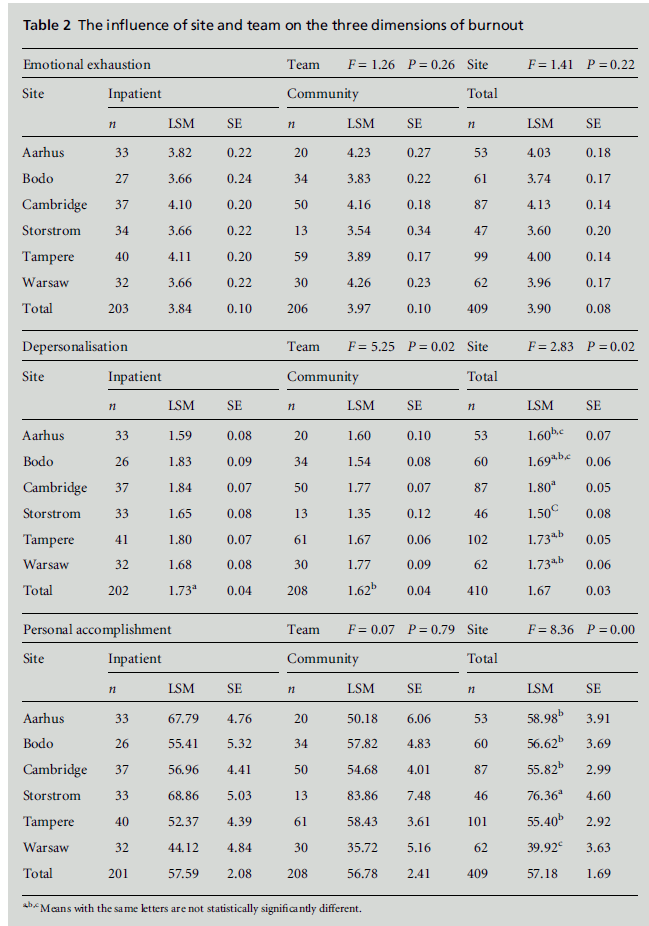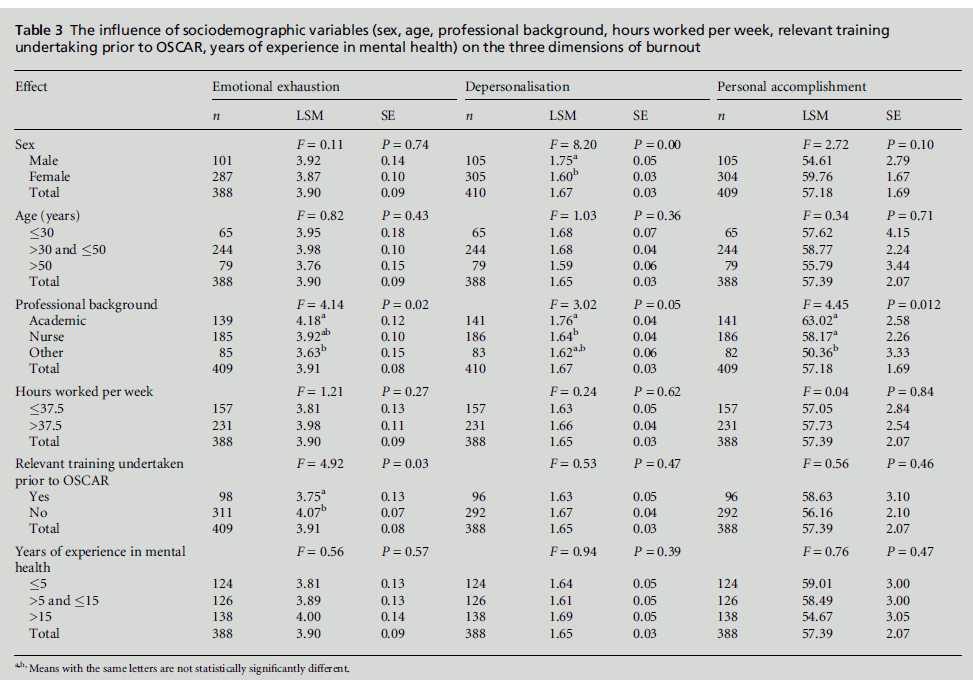Keywords
burnout, mental health, mental health
staff
Introduction
In the European Union (EU) over the last decade,
work-related stress has been consistently identified as
one of the major workplace concerns; a challenge not
only to the health of working people but also to the
healthiness of their organisations. Much evidence
suggests that stress and burnout are widespread among
the European workforce. For example, in the European
Foundation’s 1996 and 2000 surveys of working
conditions, 28% of the workers reported stress-related
problems, a figure exceeded only by the 33% who
complained of back pain problems (European Foundation
for Improvement of Living and Working
Conditions, 1996, 2000). Furthermore, studies in the
EU and beyond (Cox et al, 2000) suggest that between
50% and 60% of all lost working days are related to
stress. Work-related stress, its causes and consequences
are all very common in the EU Member States. Data
published by the European Commission in the Report
on Work-related Stress (1997) suggest that more than
half of the European workers surveyed admitted to
working under considerable pressure. More than onethird
did not have the freedom to organise their tasks,
and more than one-quarter did not have a say when it
came to deciding on their patterns of work. Furthermore,
45% claimed that they carried out monotonous
tasks, and 50% short repetitive tasks. Such work-related
‘stressors’ are likely to have contributed to the present
spectrum of ill health: 15% of theworkforce complained
of headache, 23% of neck and shoulder pains, 23%
of fatigue, 28% of ‘stress’, and 33% of backache (European
Foundation for Improvement of Living and
Working Conditions, 1996, 2001). Work-related stressors
also contribute to many other diseases, even to lifethreatening
ones (European Foundation for Improvement
of Living and Working Conditions, 2001). Both
these European Foundation surveys targeted 1000
workers per country, using a multistage random sampling
approach. Jones et al (1998) found that 26.6% of
respondents (n = 39 000) in their questionnaire-based
survey of the working population reported suffering
from work-related depression or anxiety, or a physical
condition that they attributed to work-related stress.
They also estimated that 19.5 working days were lost
due to stress-related illnesses per year. It appears that
work-related stress and burnout are significant impediments
to job satisfaction and healthy psychosocial
functioning, and can alter the behaviour of the people
involved, impairing the quality of their lives and
damaging their health.
Burnout: a definition
Burnout has been defined as ‘a syndrome of emotional
exhaustion, depersonalization and a reduced sense of personal accomplishment, which can occur among
individuals who work with people in some capacity’
(Maslach and Jackson, 1986, p.32). Burnout is a state
of physical, emotional and spiritual fatigue, and it is
caused by a long-term commitment to demanding
situations (Pines, 1993). It is described as a sense of
helplessness and hopelessness, low energy level, chronic
tiredness, fatigue, and a feeling of being trapped. Typical
also are negative feelings about self, work and life
(Hillhouse et al, 2000).One of the consequences of these
symptomatic effects can be a severe disruption or
dislocation of the therapeutic relationship between
the service provider and client (Cherniss, 1980;Maslach,
2000).
Maslach and Jackson (1986, p.61) operationally defined
burnout in terms of three factors:
• emotional exhaustion: ‘Feelings of being emotionally
over-extended and depleted of one’s emotional
resources’
• depersonalisation: ‘Negative, cynical attitudes and
feelings about other people often including a loss of
idealism’
• personal accomplishment: ‘Feelings of competency,
self-efficacy and productivity at work’.
• personal accomplishment: ‘Feelings of competency,
self-efficacy and productivity at work’.
A number of theoretical models of burnout have
been developed including: social support (Pines and
Maslach, 1978); self-efficacy (Cherniss, 1980); the
protection of resources (Hobfoll, 1989); the inequity
theory (van Dierendonck et al, 1996); the social comparison
model (Schaufeli and Enzmann, 1998); and
the phase model (Golembiewski et al, 1998). Sources
of burnout include organisational, interpersonal and
personal factors. Organisational factors may consist of
a lack of positive feedback about one’s job performance,
lack of autonomy and control in carrying out
one’s job, lack of participation in organisational decisions,
conflicting role demands, ambiguity about
one’s job role, faulty management and supervision
and work pressure (Savicki and Cooley, 1987). Interpersonal
factors may include a heavy caseload, working
too much time with clients or patients and lack of
work team support (Maslach and Jackson, 1984).
Personal factors relate to unrealistic or unmet job
expectations and lack of ideological commitment or
moral purpose in work (Cherniss, 1980). Those with
low self-confidence, lack of assertiveness, inability to
set limits, external locus of control and a strong need
for approval by others are more prone to develop the
symptoms of burnout (Capel, 1987).
Burnout in the mental health workforce
Maslach (2000) argued that mental health workers
face burnout by the very nature of their profession. A
primary professional expectation of the mental health
workforce is that they should care for their clients
through the provision of an effective therapeutic relationship.
Burnout can provide a major threat to the
legitimacy and sustainability of that relationship. The
working conditions that mental health workers face
are likely to increase the possibility of burnout: many
inpatient wards are severely overcrowded and operatingwith
bed occupancy levels above what is accepted
as safe; the incidence of violence in the mental health
workplace is high; increased workloads, under-staffing,
job insecurity and continuing rapid organisational
change have all been put forward as major sources of
burnout among mental health professionals, and confirmed
by a number of studies (Lee and Wang, 2002;
Leiter and Harvie, 1996; Sullivan, 1993).
Demographics and burnout
There is conflicting evidence about those most likely
to experience burnout. For instance, Thomsen et al
(1999) found that the male mental health workers in
their study faced violence in their work more often
than women and therefore they were more stressed.
Hannigan et al (2000) found that male nurses were
more cynical, and demonstrated higher scores in the
depersonalisation subscale of the Maslach Burnout
Inventory (Maslach and Jackson, 1986; Maslach et al,
1996). However, some studies (for example, Parry-
Jones et al, 1998; Thornton et al, 1992) have found no
correlation between gender and burnout.
In a second example, Cushway et al (1996) reported
that younger and less experienced psychologists were
more stressed when working with patients. Young
nurses were also discovered to be more exhausted
(Fielding and Weaver, 1994; Melchior et al, 1997). On
the other hand, other studies (Schulz et al, 1995;
Wykes et al, 1997) found that age was not necessarily
correlated with burnout.
Finally, there are complex linkages between professional
background and burnout, in that there are
contradictory findings between studies. For example,
Prosser et al (1996) reported that nurses and social
workers were more stressed than other caring professions
in their study. However, Thomsen et al (1999)
found that psychiatrists were more exhausted than
nurses. To¨yry (2001) found that psychiatrists suffered
more from burnout than did other physicians. On the
other hand Wykes et al (1997) and Thornton (1992)
found no relation between professional occupation
and burnout.
The aims of the study
The Occupational StresswithMental Health Clients in
Acute Response (OSCAR) study aimed to:
• compare, across six European mental health services,
the levels of occupational stress and burnout
among mental health workers in acute psychiatric
hospital and community settings
consider the aetiological factors that precipitate the
occurrence of patients’ violent behaviour
• examine the efficacy of risk-management strategies
• develop and evaluate effective stress-reduction
training packages.
The outcomes of the training intervention are
reported in Ryan et al (2005). In this article we report
on the demographic and situational variations in levels
of burnout amongst staff in six different European
centres (see Box 1). It is important to note that the
seventh centre participating in the study (Middlesex
University) acted as co-ordinating centre but did not
take part in the active research component of the
study. We wanted to explore whether there were any
particular differences in staff burnout levels in the
different sites, and if so, to explore the reasons for this.
We wanted to see whether there were any differences
between community and inpatient teams both within
and between the different sites. We were interested in
demographic variability: whether there were any differences
in burnout due to age, sex, years of experience
in mental health or professional background. Finally,
we wanted to establish whether prior exposure to
relevant training in occupational stress had any protective
effect on burnout levels.
Methods
Study design
Sources of stress and levels of burnout were studied
among acute inpatient and community staff in six
psychiatric centres in five European countries: two
from Denmark and one each from Finland, Great
Britain, Norway and Poland. The main hypotheses
guiding the study were that (1) community staff have
higher levels of burnout than acute ward staff, and (2)
that there are systematically different sources of stress
among the two groups, reflecting different organisational
surroundings and responsibilities related to, for
example, control over one’s working conditions.
The overall design for the study was a simple
longitudinal time series, with repeated measures at
baseline, six and 12 months.A baseline was established
by assessing the staff groups before they received
training specifically designed and developed to reduce levels of occupational stress, and to increase the
efficacy of risk assessment. Staff were followed up at
six and 12 months post-intervention. This design was
considered appropriate in that it would allow for the
variability of a number of potentially unknown factors
between sites. It would also overcome contamination
issues that would otherwise be problematic in a randomised
design.
Box 1 :Participating data collection centres in the OSCAR project
Thenumbers of participants per sitewere calculated
by taking into account the longitudinal design of the
study. For the study to have a type 1 error rate of 5%
(statistical significance) and type 2 error rate of 80%
(power) and treating each of the six settings, as well
as inpatient and community staff, as separate groups
(i.e. 12 groups in total) to detect an effect size of 0.5
(‘small’ to ‘medium’ effect size), and assuming that the
measures to be used have a retest correlation of 60%, the sample size required per group was approximately
26. Taking into account a dropout rate of an estimated
35%, the final sample size was 35 subjects per group
(i.e. 70 per setting, or 420 in total). Teams were randomly
selected from each site, stratified by inpatient
versus community teams, until the approximate required
sample size was reached. In some cases this resulted in
all locally available teamsentering the study (see Table 1).
Participants
The study comprised six different European psychiatric
centres (in five countries), each with inpatient
ward(s) and community team(s). The seventh centre
(Middlesex University) co-ordinated the project and
the research, but did not collect data or undertake an occupational stress intervention locally. A total of 414
mental health staff across the six settings participated in
the study. For each centre both staff working in the
inpatient units (n=205) and community mental health
teams (n = 209) were included (see Table 1). Nearly
three-quarters of the participants were women
(74.6%, n = 309) (men: 25.4%, n = 105). The mean
age of the whole group (n = 409) was 41.96 years (SE
0.50), and was slightly lower in the inpatient staff
group (n = 202; 40.06 years, SE 0.76, compared to
community staff (n = 207; 43.81 years, SE 0.62).
Table 1: Numbers of participants per centre
Ethical issues
All the participating centres successfully applied for
and achieved ethical approval for the study, and the
principle of informed consent was systematically applied.
Meetings were held with the participating staff
groups on all sites, where the rationale for the study
was explained, the nature of the intervention clarified,
and staff queries and questions answered in detail.
Each staff member was also given a briefing letter
which set out the aims and objectives of the study. All
staff signed a consent form. All questionnaires were
filled in anonymously, and only the site researchers
had access to names and codes of study participants.
Where staff left the study after the baseline period, exit
interviews were carried out to explore their reasons for
leaving.
Instruments
The Maslach Burnout Inventory (MBI) (Maslach and
Jackson, 1986) assesses three dimensions of the burnout
syndrome: emotional exhaustion, depersonalisation
and personal accomplishment. It has 22 items, scored
on a frequency-of-occurrence basis, on a seven-point
scale: from none to every day. Items examine an individual’s
feelings or attitudes towards themselves and
their work. The subscale emotional exhaustion (EE)
consists of nine items, depersonalisation (DP) of five
and personal accomplishment (PA) of eight. Scale
reliabilities (Cronbach’s alpha) are 0.90 for EE, 0.79
for DP, and 0.71 for PA. Burnout scores in the upper
one-third of the normal distribution are considered
high, those in the middle one-third moderate and
those in the bottom one-third low. Scores on EE and
DP increase as burnout increases, while scores on PA
decline (Maslach and Jackson, 1986). Reliability and
validity are satisfactory, although the factor structure
is a matter of some dispute (Kaliath et al, 1998). The
MBI has been widely used in previous studies with
mental health professionals (see, for example, Fagin
et al, 1996; McElfatrick et al, 2000; Onyett et al, 1997;
Prosser et al, 1996).
Data analysis
All statistical analyses were carried out using SPSS for
Windows, release 12.0.
The analysed MBI subscales values distribution was
verified using the Kolmogorow–Smirnow test. In
order to make the distribution close to normal the
transformation was carried out according to the
models described in Box 2.
In order to compute a within-subjects effect, a GLM
factor analysis transforms the within-subject variables
into a new set of variables – one variable for each
degree of freedom of the within-subject variable plus
one additional variable for the average of the withinsubject
factor. The analysis of variance is performed
on the transformed variables rather than on the
original within-subject variables (see Box 3). In the
analysis carried out for this paper, each factor was
analysed twice. The GLM procedure was used to
calculate the influence of the sociodemographic factors
in relation to the levels of burnout in all three
dimensions. In the first run, all factors were considered.
In the second run, the factors site, team and
others for which the value of F test in the first run was
�1 were considered. The differences in the numbers of
the participants in Tables 1–3 are due to missing data.
The transformed means of MBI subscales were used in
the calculations presented in the tables.
Box 3: The model used in GLM procedure.
Results
The influence of site and team
on emotional exhaustion,
depersonalisation and personal
accomplishment
There were no statistically significant differences between
sites and teams regarding emotional exhaustion
(see Table 2). The highest total score for EE was in
Cambridge (4.13, SE 0.14) and the lowest in Storstrom
(3.60, SE 0.20). For four of the sites, Tampere and
Storstrom excluded, scores for community teams were
higher than those for inpatient staff. The overall EE
score for the Warsaw community teams was higher
than for any other team on any other site (see Table 2).
Cambridge had the highest score for depersonalisation
in respect to both inpatient and community
teams. The community teams in Warsaw achieved
similar scores (1.77 respectively, SE 0.07 and 0.09
respectively). In addition, there was a statistically
significant difference between the Cambridge total
score (1.80, SE 0.05) and that of Storstrom (1.50, SE
0.08), which scored lowest of all the sites (see Table 2).
There were statistically significant site differences
with respect to personal accomplishment (see Table
2). Storstrom (76.36, SE 4.60), scored significantly
lower on this factor than any other site with regard to
both inpatient and community team scores. Both
Warsaw teams scored significantly higher than any
other site (39.92, SE 3.63). However, it should be
noted that community team numbers in Storstrom
were low (n = 13). It is worth noting that the scores of
the A˚ arhus teams were also relatively low for PA
(58.98, SE 3.91), the community teams for this site
scoring somewhat higher (50.18, SE 6.06) than the
inpatient teams (67.79, SE 4.76) (see Table 2).
The influence of sociodemographic
variables (sex, age, professional
background, hours worked per week,
relevant training undertaking prior to
OSCAR, years of experience in mental
health) on emotional exhaustion,
depersonalisation and personal
accomplishment
Table 2: The influence of site and team on the three dimensions of burnout.
Table 3: The influence of sociodemographic variables (sex, age, professional background, hours worked per week, relevant training
undertaking prior to OSCAR, years of experience in mental health) on the three dimensions of burnout.
There were statistically significant differences regarding
emotional exhaustion with respect to professional
background and relevant prior training. The highest
levels were observed among professionally qualified
staff, who scored significantly higher than occupational
groups such as administrative staff.
Staff (n = 98) who had received previous training
about occupational stress prior to this study experienced
significantly less emotional exhaustion compared
to those with no prior relevant training (n = 311). This
second group, numerically over three-quarters (76%)
of the total staff group in the study, experienced the
highest level of emotional exhaustion compared to all
the other factors to which it was compared (see Table 3).
The highest values of depersonalisationwere observed
among professionally qualified staff, who scored
significantly higher than other occupational groups.
Gender was statistically significant (P = 0.00), with
men having significantly higher levels of depersonalisation
than women (see Table 3). The highest values
of personal accomplishment were observed among
other occupational groups who scored significantly
higher than professionally qualified staff (see Table 3).
Discussion
This study presents the demographic and situational
variations in levels of occupational burnout among
community and inpatient staff located in A ˚ arhus and
Storstrom in Denmark, Cambridge in the UK, Bodø in
Norway, Tampere in Finland and Warsaw in Poland.
We argue that the EE scores for the Warsaw community
teams were high (EE 4.26, SE 0.23; DP 1.77,
SE 0.09) because of the financial resource conditions
the community teams were operating under. The
OSCAR study was conducted during a period of reform
of the healthcare finance systems in Poland, which,
since April 2003, resulted in a massive loss of funding
allocated to Polish mental health services. We know,
from the qualitative interviews data, that this situation
resulted in a lot of tension, disappointment and
frustration, a sense of low control, and apprehension
about possible job losses. Polish salaries in the mental
health system are extremely low, while the demands
are high. One staff member summed it up by saying:
‘Even if we try to do something, and establish a plan,
no one will notice it positively, and the next changewill
ruin everything’. It is not surprising, therefore, that the
Polish teams felt helpless, without satisfactory support.
This is evidenced by the Polish community
teams reporting 40 hours work each week plus
20.5 paid overtime and five hours unpaid work per
week, and 2.5 hours travelling time during work per
day.
It is somewhat surprising, therefore, that the Polish
teams also scored highest in personal accomplishment.
It could perhaps be partially explained by there
being, in Polish Catholic culture, a strong vocational
element which commits the individual to an ethic of
service no matter what. It could also be explained by the
fact that for all the difficulties of the Polish economy, working in mental health services represented a secure,
permanent guarantee of employment, something to
be prized highly in a context of high unemployment.
As to why the Storstrom teams scored low in
personal accomplishment, it may be relevant that
the inpatient staff worked in a forensic unit, dealing
with a particularly difficult group of patients and that
this had an adverse effect on their scores. It could also
be that the psychiatric profession in Denmark was not
so highly valued as a secure source of employment as it
was in Poland.However, thenumber of participants in
Storstrom was relatively low (n = 47) compared to
other sites, and so interpretations of site data should
be treated with caution.
The Cambridge teams scored very highly with
respect to both EE (total 4.13, SE 0.14) and depersonalisation
(total 1.80, SE 0.05). At the time of the study
they were going through a period of massive organisational
change and restructuring, which may have
added to their workload and led to a sense of loss of
control through lack of consultation.
In overall terms it is noteworthy that professionally
qualified staff scored significantly higher in EE (4.18,
SE 0.12) and DP (1.76, SE 0.04), while also scoring
lowest in terms of PA (63.02, SE 2.58). It is possible
that this was because in most of the services studied,
they occupied higher managerial positions, with wider
responsibilities and greater workloads. Another notable
finding was the apparently prophylactic effect on
burnout of previous training about occupational stress.
We know from this study that those previously exposed
to relevant training scored significantly lower
with respect to EE than those with no prior exposure.
This is both reassuring and somewhat puzzling. It is
reassuring that prior training might have had a protective
effect, but suggests that the more recent
OSCAR training had no positive impact at all (Ryan
et al, 2005).
Younger staff members (�30 years and >30 and
�50 years) scored higher on DP than did older staff
members (>50 years), and this is explicable in terms of
relatively inexperienced staff being less prepared to
manage environmental stressors (see, for example,
Cushway et al, 1996).
Finally, our study indicated that men in the study
scored significantly higher on DP than did women.
This may be explicable in terms of men being exposed
to higher levels of violence than women (see for
example Thomsen et al, 1999). We are not, however,
as yet able to confirm this from our own data.
Study limitations and strengths
This study is unusual in two respects. First, it offers a
comparative baseline for the analysis of stress and
burnout across six European mental health services. Secondly, it attempts to evaluate the results of a teambased
intervention designed to reduce stress and
burnout, the results of which are reported in Ryan
(2005).
The main methodological limitation concerning
the present study was the small sample sizes at some
of the sites; for example, the total size of the community
team sample on the Storstrom site was only 13.
Consequently, the values of the scales were not distributed
normally. Accordingly, the scores were transformed
in order to make the distribution adhere more closely
to normal distribution.
Conclusion
This study was the first to analyse across six European
sites the impact of demographic and situational factors
in terms of contributing to variations in levels of
burnout in six European mental health services. We
found that high levels of emotional exhaustion (as
found in Warsaw, for example) did not necessarily
correlate with low levels of personal accomplishment.
A consistent finding in the data was that prior exposure
to relevant occupational stress training did
have a prophylactic effect in reducing current levels of
burnout dimensions.We also found consistently across
settings that men scored higher on the depersonalisation
subscale of the MBI than did women. This study
would also suggest that professionally qualified staff
also scored higher in all three MBI factors of personal
accomplishment, emotional exhaustion and depersonalisation
than did unqualified staff or administrative
staff. If nothing else, this study is a confirmation of the
complex, multifactorial nature of occupational stress,
and shows that cross-cultural collaboration as demonstrated
in the OSCAR project can make a valuable
contribution to the clarification of these complex issues.
Acknowledgements
Many colleagues contributed to the OSCAR Study.
Cambridge University (UK): Mervyn London, Jill
Butler, Iliana Rokkou; Middlesex University (UK):
Peter Ryan, Robert Hill, Colette Turner, Polly Hardy,
Dan Smith; A˚ arhus (Denmark): Kerstin Back Moller,
Vibeke Sjogren, Klavs Nybjerg Svendsen; Storstrom
(Denmark): Rita Mejer, Birgitte Anderson, Merete
Nordentoft,Katia Nielsen; Bodø (Norway): IanDawson,
Knut Soergaard, Liss Eberg; Tampere (Finland): Heli
Laijarvi; Warsaw (Poland): Czeslaw Czabala, Anna
Kurek, Julita Smolarska, Piotr Switaj.
We would also like to acknowledge the sustained
and valuable assistance of ENTER Mental Health
Group and all the participants of the study in all the
centres.
References
- Ackerley G D, Burnell J, Holder DC and Kurdek LA (1988) Burnout among licensed psychologists. Professional Psychology: Research and Practice 19:624–31.
- Capel SA (1987) The incidence of and influences on stress and burnout in secondary school teachers. British Journal of Educational Psychology 57:279–88.
- Cherniss C (1980) Professional Burnout in Human Service Organizations. New York: Praeger.
- Corrigan P, Holmes P and Luchins D (1995) Burnout and collegial support in state psychiatric hospital staff. Journal of Clinical Psychology 51: 703–10.
- Cox T, Griffiths AJ and Rial-Gonzalez E (2000) Research on Work-related Stress. Report to the European Agency for Safety and Health at Work. Luxembourg: Office for Official Publications of the European Communities.
- Cushway D, Tyler PA and Nolan P (1996) Development of a stress scale for mental health professionals. British Journal of Clinical Psychology 35:279–95.
- Edwards D, Burnard P, Coyle D, Fothergill A and Hannigan B (2000) Stress and burnout in community mental health nursing: a review of the literature. Journal of Psychiatric and Mental Health Nursing 7:7–14.
- Elovainio M, Sinervo T and Pekkarinen L (2001) Uusien Tyo¨va¨lineiden Omaksuminen. Asenteet, tyo¨n sisa¨lto¨, yhteistyo¨ ja prosessi muutosta edista¨vina¨ tekijo¨ina¨ perusterveydenhuollossa. Stakes Aiheita 1/2001. Helsinki: Stakes.
- European Commission (1997) Report on Work-related Stress. Luxembourg: The Advisory Committee for Safety, Hygiene and Health Protection at Work.
- European Foundation for the Improvement of Living and Working Conditions (1996) Second European Survey on Working Conditions. Dublin: European Foundation for the Improvement of Living and Working Conditions.
- European Foundation for the Improvement of Living and Working Conditions (2001) Third European Survey on Working Conditions. Dublin: European Foundation for the Improvement of Living and Working Conditions.
- Fagin L, Brown D, Bartlett H, Leary J and Carson J (1995) The Claybury Community Psychiatric Nurse Stress Study: is it more stressful to work in hospital or the community? Journal of Advanced Nursing 22:347–58.
- Fagin L, Carson J, Leary J et al (1996) Stress, coping and burnout in mental nurses: findings from three research studies. International Journal of Social Psychiatry 42:102– 11.
- Fielding J and Weaver SM (1994) A comparison of hospital and community-based mental health nurses: perception of their work environment and psychological health. Journal of Advanced Nursing 19:1196–204.
- Fox M, Dwyer DJ and Ganster DC (1993) Effects of stressful job demands and control on psychological and attitudinal outcomes in a hospital setting. Academy of Management Journal 36:289–318.
- Freudenberger HJ (1974) Staff burn-out. Journal of Social Issues 30:159–65.
- Garzotto N, Carcereri G, Turrina C and Ballarini C (1992) The syndrome of burn-out among mental health professionals in Verona (Italy). New Trends in Experimental and Clinical Psychiatry 8:113–18.
- Burnout in European mental health services 111 Golembiewski RT, Boudreau RA, Sun B-C and LuoH(1998) Estimates of burnout in public agencies. Public Administration Review 58:59–65.
- Hannigan B, Edwards D, Coyle D, Fothergill A and Burnard P (2000) Burnout in community mental health nurses: findings from all-Wales stress study. Journal of Psychiatric and Mental Health Nursing 7:127–34.
- Harper H and Minghella E (1997) Pressures and rewards of working in community mental health teams. Mental Health Care 1:18–21.
- Hill R, Turner C, Cooper W and Ryan P (2003) Occupational Stress with Mental Health Clients in Acute Response (OSCAR): a brief overview of measures. Journal of Health, Social and Environmental Issues 4:17–21.
- Hillhouse JJ, Adler CM and Walters DN (2000) A simple model of stress, burnout and symptomology in medical residents: a longitudinal study. Psychology, Health and Medicine 5:63–73.
- Hobfoll SE (1989) Conservation of resources. American Psychologist 44:513–24.
- International Labour Office (ILO) (1992) Preventing stress at work. Conditions of Work Digest 11:2.
- Jones J, Huxtable C, Hodgson J and Price M (1998) Selfreported Work-related Illness in 1995. London: HSE Books.
- Kalimo R (1987) Stressi ja psyykkinen kuormitus tyo¨ela¨ma¨ssa¨.(Stress and burnout in work). In: Lindstro¨m K and Kalimo R (eds) Tyo¨psykologia. Terveys ja ela¨ma¨nlaatu Tyo¨terveyslaitos(Occupational Psychology). Helsinki: Finnish Institute of Occupational Health, pp.50–72.
- Kalliath TJ, O’Driscoll MP and Gillespie DF (1998) The relationship between burnout and organizational commitment in two samples of health professionals. Work and Stress 12(2):179–85.
- Karasek R and Theorell T (1990) Healthy Work Stress, Productivity, and the Reconstruction of Working Life. New York: Basic Books.
- Kauppinen-Toropainen K (1991) Tyo¨uupumus hoitotyo ¨ssa¨: henkinen va¨symys, kovettuminen ja tyo¨nilon lasku miehilla¨ ja naisilla (Burnout in nursing: emotional exhaustion, depersonalization and reduced sense of personal accomplishment by men and women). Tyo¨ ja Ihminen 5:275–94.
- Kilfedder C, Power K and Wells T (2001) Burnout in psychiatric nursing. Journal of Advanced Nursing 34: 383–96. Lazarus RS(1993) From psychological stress to the emotions: a history of changing outlooks. Annual Reviews of Psychology 44:1–21.
- Lazarus RL and Folkman S(1984) Stress, Appraisal, and Coping. New York: Springer. Lee I and Wang HH (2002) Perceived occupational stress and related factors in public health nurses. Journal of Nursing Research 10:253–9.
- Leiter MP and Harvie PL (1996) Burnout among mental health workers: a review and a research agenda. International Journal of Social Psychiatry 42:90–101. Lindholm H and GockelM(2000) Stressin elinvaikutuksien mittaaminen (How to measure the impact of stress on human organisations). Duodecim 116:2259–65.
- Maslach C (2000) Wypalenie – w perspektywie wielowymiarowej (Burnout – multidimensional perspective). In: Seˆk WH (ed) Wypalenie zawodowe – przyczyny, mechanizmy, zapobieganie (Burnout – rationales, processes, prophylactic). Warsaw: Wydawnictwo Naukowe PZWL.
- Maslach C and Jackson SE (1984) Patterns of burnout among a national sample of public contact workers. Journal of Health and Human Resources Administration 7:189–211.
- Maslach C and Jackson SE (1986) Maslach Burnout Inventory Manual. Palo Alto: Consulting Psychologists Press. Maslach C and Marek T (eds) Professional Burnout. Recent developments in theory and research. Washington DC: Taylor and Francis, pp.33–51.
- Maslach C, Jackson SE and Leiter MP (1996). Maslach Burnout Inventory Manual (3e). Palo Alto: Consulting Psychologist Press. McElfatrick, S, Carson, J, Annett J et al (2000) Assessing coping skills in mental health nurses: is an occupation specific measure better than a generic coping skills scale? Personality and Individual Differences 28:965–76.
- Mehrotra S, Rao K and Subbakrishna DK (2000) Factor structure of Mental Health Professionals Stress Scale (MHPSS) among clinical psychologists in India. International Journal of Social Psychiatry 46:142–50.
- Melchior MEW, Bours GJJW, Schmitz P and Wittich Y (1997) Burnout in psychiatric nursing: a meta-analysis of related variables. Journal of Psychiatric and Mental Health Nursing 4:193–201.
- Onyett S, Pillinger T and Muijen M (1997) Job satisfaction and burnout among members of community mental health teams. Journal of Mental Health 6:55–66.
- Parry-Jones B, Grant G, McGrath M et al (1998) Stress and job satisfaction among social workers, community nurses and community psychiatric nurses: implications for the care management model. Health and Social Care in the Community 6:271–85.
- Pines AM (1993) Burnout: an existential perspective. In: SchaufeliWB, Maslach C and Marek T (eds) Professional Burnout. Recent developments in theory and research. Washington DC: Taylor and Francis, pp.33–51.
- Pines A and Maslach C (1978) Characteristics of staff burnout in mental health settings. Hospital and Community Psychiatry 29: 233–237. Prosser D, Johnson S, Kuipers E et al (1996) Mental health, burnout and job satisfaction amongst hospital and community-based mental health staff. British Journal of Psychiatry 169:334–7.
- Prosser D, Johnson S, Kuipers E et al (1997) Perceived sources of work stress and satisfaction among hospital and community staff and their relation to mental health, burnout and job satisfaction. Journal of Psychosomatic Research 43:51–9.
- Raquepaw JM and Miller RS(1989) Psychotherapist burnout: a componential analysis. Professional Psychology: Research and Practice 20:32–6.
- Ryan P, Hill R, Anczewska M, Turner C and Hardy P (2005) The management of occupational stress in European mental health services. International Review of Psychiatry 13: 39–49.
- Savicki V and Cooley E (1987) The relationship of work environment and client contact to burnout in mental health professionals. Journal of Counseling and Development 65:249–52.
- Schaufeli W and Enzmann D (1998) The Burnout Companion to Study and Practice: a critical analysis. London: Taylor and Francis.
- Schulz R, Greenlay JR and Brown R (1995) Organization, management, and client effects on staff burnout. Journal of Health and Social Behavior 36:333–45.
- Selye H (1976) Stressi. Helsinki: Kirjayhtyma¨. Snibbe JR, Radcliffe T, Weisberger C, RichardsMand Kelly J (1989) Burnout among primary care physicians and mental health professionals in managed health care setting. Psychological Reports 65:775–80.
- Sullivan PJ (1993) Occupational stress in psychiatric nursing. Journal of Advanced Nursing 18:591–601.
- Sutherland VJ and Cooper CL (1990) Understanding Stress. A psychological perspective for health professionals. London: Chapman and Hall.
- Thomsen S, Soares J, Nolan P, Dallender J and Arnetz B (1999) Feelings of professional fulfilment and exhaustion in mental health personnel: the importance of organizational and individual factors. Psychotherapy and Psychosomatics 68:157–64.
- Thornicroft G (1996) Mental health, ‘burnout’ and job satisfaction among hospital and community-based mental health staff. British Journal of Psychiatry 169:334–7.
- Thornton PI (1992) The relation of coping, appraisal, and burnout in mental health workers. Journal of Psychology 126:261–71. To¨yry S(2001). Miten la¨a¨ka¨rit jaksavat tyo¨ssa¨a¨n? (How do medical doctors cope with their work?) Tyo¨terveiset 2:14– 16. T
- urnipseed D (1994) An analysis of the influence of work environment variables and moderators in the burnout syndrome. Journal of Applied Social Psychology 24:782– 800.
- Vahtera J (1993) Tyo¨n hallinta, sosiaalinen tuki ja terveys. Tyo¨ ja Ihminen. Tyo¨ympa¨risto¨tutkimuksen aikakausikirja. (How to manage work stress, social support and health) Lisa¨numero 1/93. Turku: University of Turku.
- van Dierendonck D, Schaufeli WB and Buunk BP (1996). Inequity among human service professionals: measurement and relation to burnout. Basic and Applied Social Psychology 18:429–51.
- Whittington R and Wykes T (1992) Staff strain and social support in a psychiatric hospital following assault by a patient. Journal of Advanced Nursing 17:480–6.
- Wilcoxon SA (1989) Leadership behavior and therapist burnout: a study of rural agency settings. Journal of Rural Community Psychology 10:3–14.
- Wykes T, Stevens W and Everitt B (1997) Stress in community care teams: will it affect the sustainability of community care? Social Psychiatry and Psychiatric Epidemiology 32: 398–407.

